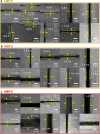Atomic-scale observation of premelting at 2D lattice defects inside oxide crystals
- PMID: 37081020
- PMCID: PMC10119109
- DOI: 10.1038/s41467-023-37977-w
Atomic-scale observation of premelting at 2D lattice defects inside oxide crystals
Abstract
Since two major criteria for melting were proposed by Lindemann and Born in the early 1900s, many simulations and observations have been carried out to elucidate the premelting phenomena largely at the crystal surfaces and grain boundaries below the bulk melting point. Although dislocations and clusters of vacancies and interstitials were predicted as possible origins to trigger the melting, experimental direct observations demonstrating the correlation of premelting with lattice defects inside a crystal remain elusive. Using atomic-column-resolved imaging with scanning transmission electron microscopy in polycrystalline BaCeO3, here we clarify the initiation of melting at two-dimensional faults inside the crystals below the melting temperature. In particular, melting in a layer-by-layer manner rather than random nucleation at the early stage was identified as a notable finding. Emphasizing the value of direct atomistic observation, our study suggests that lattice defects inside crystals should not be overlooked as preferential nucleation sites for phase transformation including melting.
© 2023. The Author(s).
Conflict of interest statement
The authors declare no competing interests.
Figures








References
LinkOut - more resources
Full Text Sources

